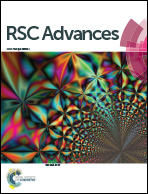The nature of metal–metal bonding in Re-, Ru- and Os-corrole dimers†
Abstract
Studies of multiple bonding between transition metal complexes offer fundamental insight into the nature of bonding between metal ions and facilitate predictions of the physical properties and the reactivities of metal complexes containing metal–metal multiple bonds. Here we report a computational interrogation on the nature of the metal–metal bonding for neutral, oxidized, and reduced forms of dinuclear rhenium and osmium corrole complexes, [{Re[TpXPC]}2]0/1+/1− and [{Os[TpXPC]}2]0/1+/1−, using a complete active space self-consistent (CASSCF) methodology and density functional theory (DFT) calculations. For [{Re[TpXPC]}2]0, [{Ru[TpXPC]}2]0, and [{Os[TpXPC]}2]0, CASSCF calculations shows that the effective bond order is 3.29, 2.63, and 2.73, respectively. On their oxidized forms, [{Re[TpXPC]}2]1+, [{Ru[TpXPC]}2]1+, and [{Os[TpXPC]}2]1+ molecules, the results indicate an electron removal from a ligand-based orbital, where [{Re[TpXPC]}2]1+ gives slightly different geometry from its neutral form due to populating the δ* orbital. In this regard, the CASSCF calculations give an effective bond order of 3.25 which is slightly lower than in the [{Re[TpXPC]}2]0. On their reduced forms, the electron addition appears to be in the metal-based orbital for [{Re[TpXPC]}2]1− and [{Ru[TpXPC]}2]1− whereas in the ligand-based orbital for the Os-analogue which has no effect on the Os–Os bonding, an effective bond order of 3.18 and 2.17 is presented for the [{Re[TpXPC]}2]1− and [{Ru[TpXPC]}2]1−, respectively, within the CASSCF simulations. These results will further encourage theoreticians and experimentalists to design metalloporphyrin dimers with distinct metal–metal bonding.



 Please wait while we load your content...
Please wait while we load your content...